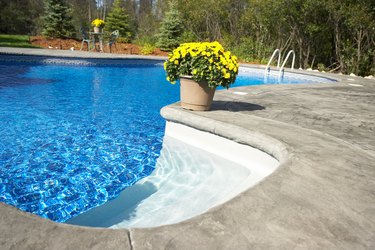
Pool steps, docks and other surfaces that are subject to foot traffic while damp or wet can easily present an inconvenience or even create a safety hazard. A handful of materials can be utilized to create a nonskid surface. These materials are as varied as adhesive strips and tapes, and coatings or sprays, and additives that can be mixed in with paint or sealant.
Adhesive Strips
Video of the Day
Slippery areas can generally be addressed most quickly with the application of anti-slip tape or a similar adhesive. Anti-slip tape for pool use is often made of vinyl, though tape made with rougher, more durable materials like silicone carbide may be most suitable for docks that see heavy traffic. Anti-slip adhesives are available in a variety of colors. If the tape is applied to pool steps that are constantly submerged, be sure to use a tape labeled for underwater use.
Video of the Day
Paint and Sealant Additives
Nonskid additives can be mixed into paints or sealants that are applied to pools, decks or other surfaces. Additives range from polymers to aggregates like sand or crushed pumice. In addition to being mixed into the paint, in some cases it may be feasible to broadcast the granules across the surface of freshly applied paint or sealant. There are also commercially-available paints for concrete and wood surfaces that have nonskid additives already mixed in.
Coatings and Sprays
A broad array of products can be applied as coatings by themselves rather than be used as an additive to paint. Possible coating materials include epoxies, urethane, water-based coatings and green building-compliant rubberized coatings that contain recycled materials. A nonslip coating that can be applied as an aerosol spray provides additional options and allows the applicator to create unique shapes or apply the material more selectively through the use of stencils.
Surface Preparation and Other Considerations
Most products are accompanied by manufacturer instructions that pertain to surface preparation and application. Follow these directions for best results. Preparation typically includes ensuring that the application surface is dry, clean and free of wax, oil and other contaminants. Some products may adhere best if the step or dock surface is lightly sanded or etched.